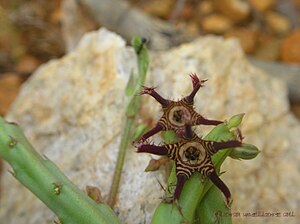Note: This is a project under development. The articles on this wiki are just being initiated and broadly incomplete. You can Help creating new pages.
Caralluma Fimbriata
Caralluma Fimbriata is a small shrub with basally trailing. It will grow upto 30 - 60cm tall. The stem bases are up to 2cm in diameter.
The plant is harvested from the wild as a local source of food and medicine. A popular traditional medicine it is also cultivated in many localities. Several patents have been issued on the preparation of the plant extract and the use of the pregnane glycosides in the treatment of obesity-related problems.
Contents
[hide]- 1 Uses
- 2 Parts Used
- 3 Chemical Composition
- 4 Common names
- 5 Properties
- 6 Habit
- 7 Identification
- 8 List of Ayurvedic medicine in which the herb is used
- 9 Where to get the saplings
- 10 Mode of Propagation
- 11 How to plant/cultivate
- 12 Commonly seen growing in areas
- 13 Photo Gallery
- 14 References
- 15 External Links
Uses
Ear infections, Wounds, Children's coughs, Cardiac problems, Vomiting, [[:Category:Ayurvedic Herbs known to be helpful to treat Epilepsy[|Epilepsy[]][[Category:Ayurvedic Herbs known to be helpful to treat Epilepsy[]].
Parts Used
[[:Category:Herbs with used in medicine|]].
Chemical Composition
Common names
| Language | Common name |
|---|---|
| Kannada | Maakada singi, Mangana kodu |
| Hindi | |
| Malayalam | |
| Tamil | |
| Telugu | |
| Marathi | |
| Gujarathi | |
| Punjabi | |
| Kashmiri | |
| Sanskrit | |
| English | Caralluma |
Properties
Reference: Dravya - Substance, Rasa - Taste, Guna - Qualities, Veerya - Potency, Vipaka - Post-digesion effect, Karma - Pharmacological activity, Prabhava - Therepeutics.
Dravya
Rasa
Guna
Veerya
Vipaka
Karma
Prabhava
Habit
Identification
Leaf
| Kind | Shape | Feature |
|---|---|---|
| Ovate | Sub-acute | Rhomboid or slightly cordate at base |
Flower
| Type | Size | Color and composition | Stamen | More information |
|---|---|---|---|---|
| Borne in racemes | Blue | Velvet hairy. Flowering season is August-December | {{{5}}} |
Fruit
| Type | Size | Mass | Appearance | Seeds | More information |
|---|---|---|---|---|---|
| Bitter | Matured fruits change colour to orange. Fruiting season is August-December |
Other features
List of Ayurvedic medicine in which the herb is used
Where to get the saplings
Mode of Propagation
[[:Category:Index of Plants which can be propagated by |]]
How to plant/cultivate
A plant of lowland areas in the drier tropics where it is found at elevations up to 1,000 metres. It tolerates high temperatures and an annual rainfall as low as 400mm.[3]
Commonly seen growing in areas
Photo Gallery
References
External Links
- [ ]
- [ ]
- [ ]
- Ayurvedic Herbs known to be helpful to treat Ear infections
- Ayurvedic Herbs known to be helpful to treat Wounds
- Ayurvedic Herbs known to be helpful to treat Children's coughs
- Ayurvedic Herbs known to be helpful to treat Cardiac problems
- Ayurvedic Herbs known to be helpful to treat Vomiting
- Herbs with used in medicine
- Herbs with common name in Kannada
- Herbs with common name in English
- Habit - Shrub
- Index of Plants which can be propagated by
- Herbs that are commonly seen in the region of Gravelly soils
- Herbs that are commonly seen in the region of Rocky hills
- Herbs


